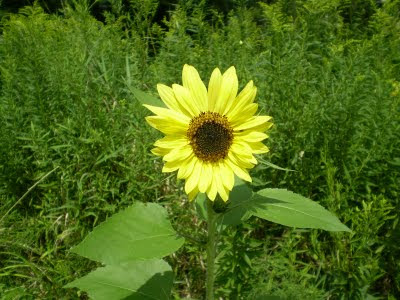
src="http://pagead2.googlesyndication.com/pagead/show_ads.js">
Hatch Hollow
It has been a tough season for home vegetable gardens but Morgan and Mike's vegetable plot in Hatch Hollow is doing really well. The one problem seems to be cucumbers which are dying. Here's Morgan's description in an email the other day:
“Got tons of broccoli, beans, peas, lettuce, beets, tomatoes, cabbage, celery, kale, and my pumpkin patch, as I call it, is doing awesome too. No pictures, but HUGE pumpkins, I planted mt squash plants with them and have tons of zucchini and summer squash! Planted tons of sunflowers and Indian corn also for wedding decorations.”
Mike and Morgan will tie the knot in October and I am sure there will be garden foods and, from the garden, decorations for the big event.
They use a lot of companion plantings in their garden, and Morgan, is currently working on putting together a pollinator/perennial garden this fall in between wedding plans.
Hatch Hollow is a small community, a blink and miss it sort of place. There is no grocery store, no gas station, but a small church and cemetery and a cluster of homes.
The place had one former resident who reached national prominence, Ida Tarbell. Tarbell was born in a small cabin not far from the pictured garden. She and her family moved later to Pithole during the great oil boom there around 1866 and then when the oil ran out in the Pithole area, moved to Titusville. Ida Tarbell is best known for her still respected biography of Abraham Lincoln, and the classic History of Standard Oil.
Note: If you want to send a garden picture with some notes, please leave a comment at the end of the blog. Thanks.
Fall Garden and Think Spring
August and September are good gardening months. There are many vegetables which can still be planted and harvested before winter arrives. Peas, beets, turnips, broccoli, lettuce and other greens are good options.
This is also a good time to re-do or establish perennial beds for pollinators and to get the compost pile started again for better soil nutrients for next year. August and September are also good months to think about and plant cover crops like buckwheat and oats which will help to suppress weeds while adding good nutrients to the soil. Cover crops also give added protection to the microbes living unseen in the soil but which are critical to organic gardening success.
Fall Vegetable Plantings: A Good Opportunity
A fall vegetable garden offers many opportunities for an extended harvest season and a spring head-start next year.
http://www.associatedcontent.comarticle/2048567/fall_vegetable_plantings_a_good_opportunity.html
Independent Book Stores keep the money local. Buy from your Independent Book Store. Click on the link below to buy a book from the nearest Independent Book Store.

_____________________________________________________
H1N1
sm.jpg)
There will likely be a lot of sick people, down with the flu. Government estimates indicate that half of the population will suffer from the flu and upwards of 90,000 could die. Eat healthy, wash your hands frequently and if you feel sick, stay home. For more information and CDC updates click on the link below. The flu season is coming early and in fact has already begun in several US communities.
Fleas and Ticks
Darn critters bother us and the pets. But be careful using some of the spot-on treatments. They could harm you and your pets. Use caution and read the link below for further information.
Fleas and Ticks: A Nightmare for Pets and You
Some flea and tick treatments pose risks to humans and pets.
http://www.associatedcontent.comarticle/2084141/fleas_and_ticks_a_nightmare_for_pets.html
For the Heck of IT:
In some regions, a weather folklore claims an abundance of American Mountain Ash berries in August and September indicates a mild winter. This year there seems to be an abundance of berries (could we be so lucky) The berries can also be used to make a jelly or jam. As far as the prediction, we'll have to wait and see; what happens, happens. But it is fun to dream.
Yesterday is history, tomorrow a mystery, today is a Gift.
Blogs that are good to read and informative:
Vincent di Fondi- Vincent just published his first novel, Blessed Abduction, available through the link above, Indie Books. Or check his blog to learn more about the novel and his new home in Costa Rica.
On Your Way to the Top – Kathleen always has good insights.
New York's Southern Tier – A travel destination in nearby New York by Richardson
Urban Veggie Blog – Dan is located in nearby Ontario and is a good gardener.Dan has some creative meals from the garden.
Other articles I have written for Helium can be found by clicking the title; other articles can be found below in the box at HubPages.
SEARCH BOC CODE FOR GOOGLE
















